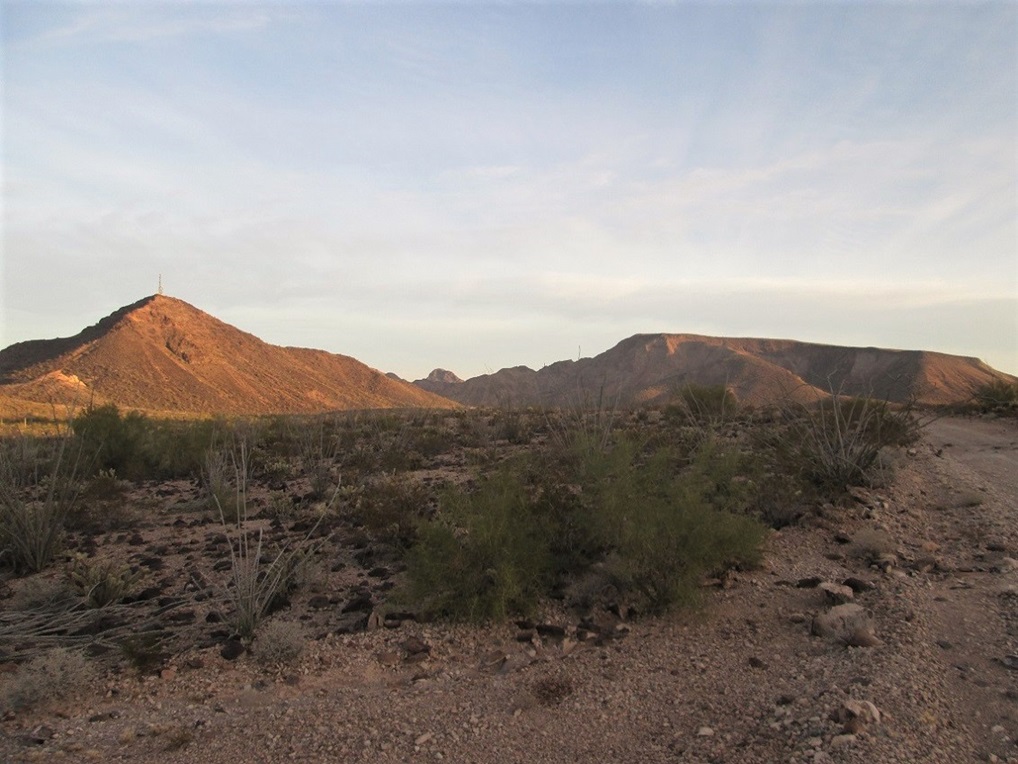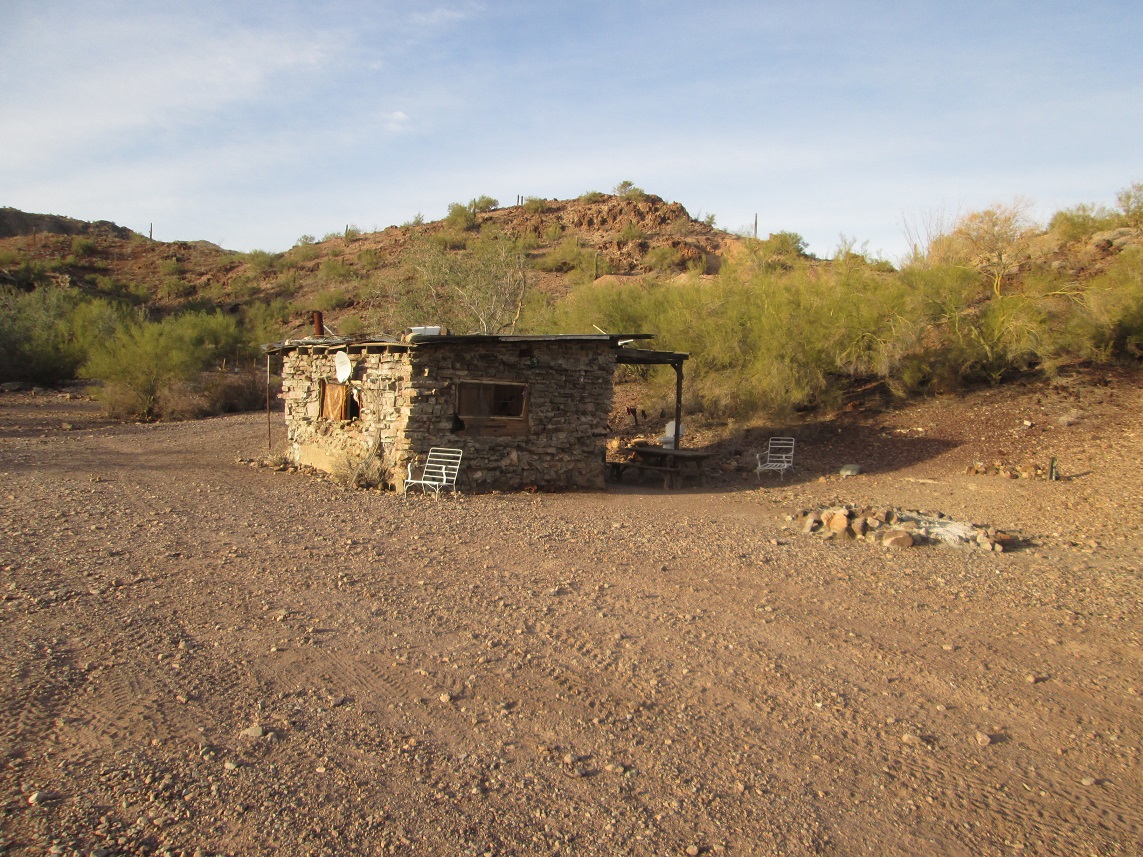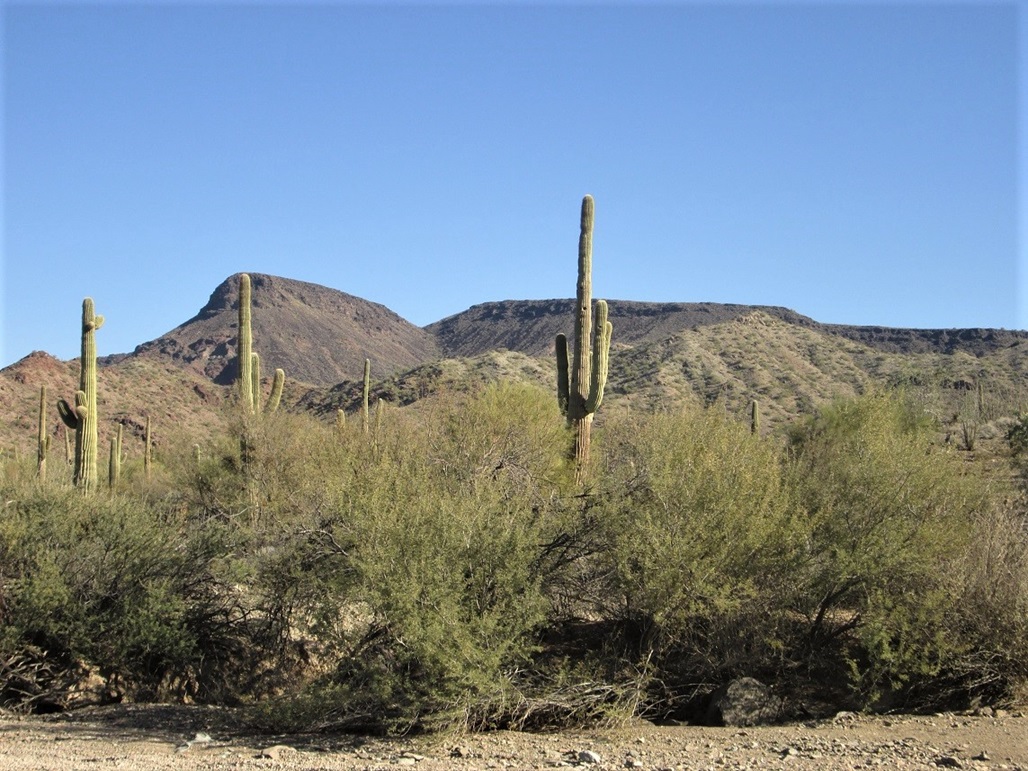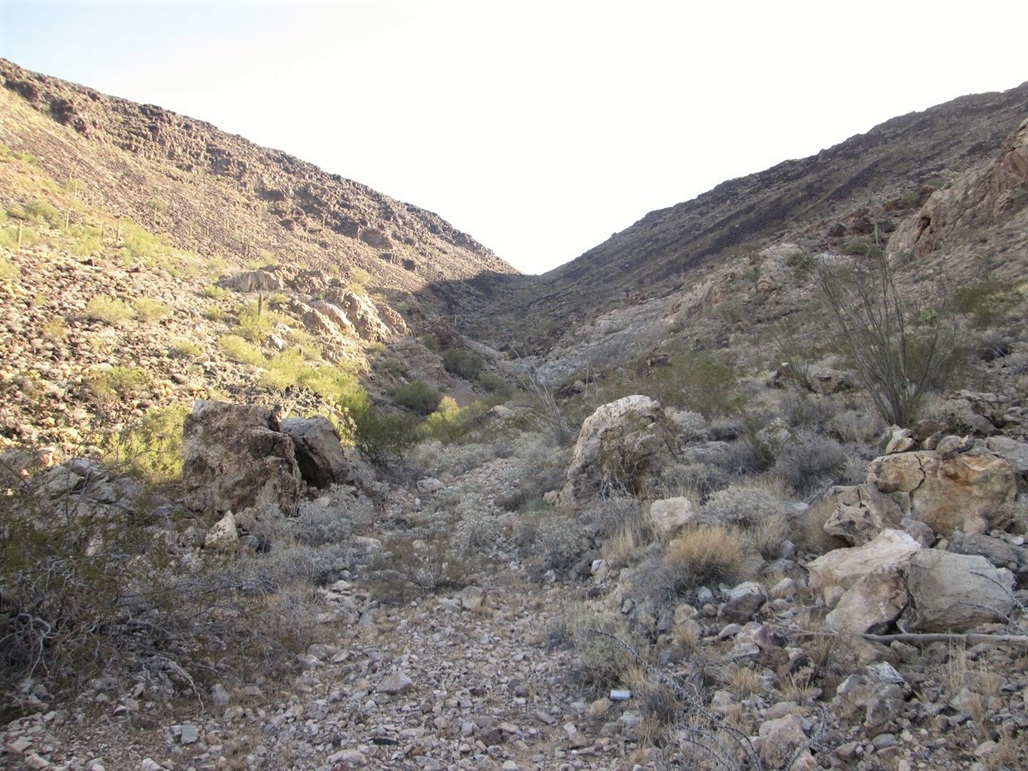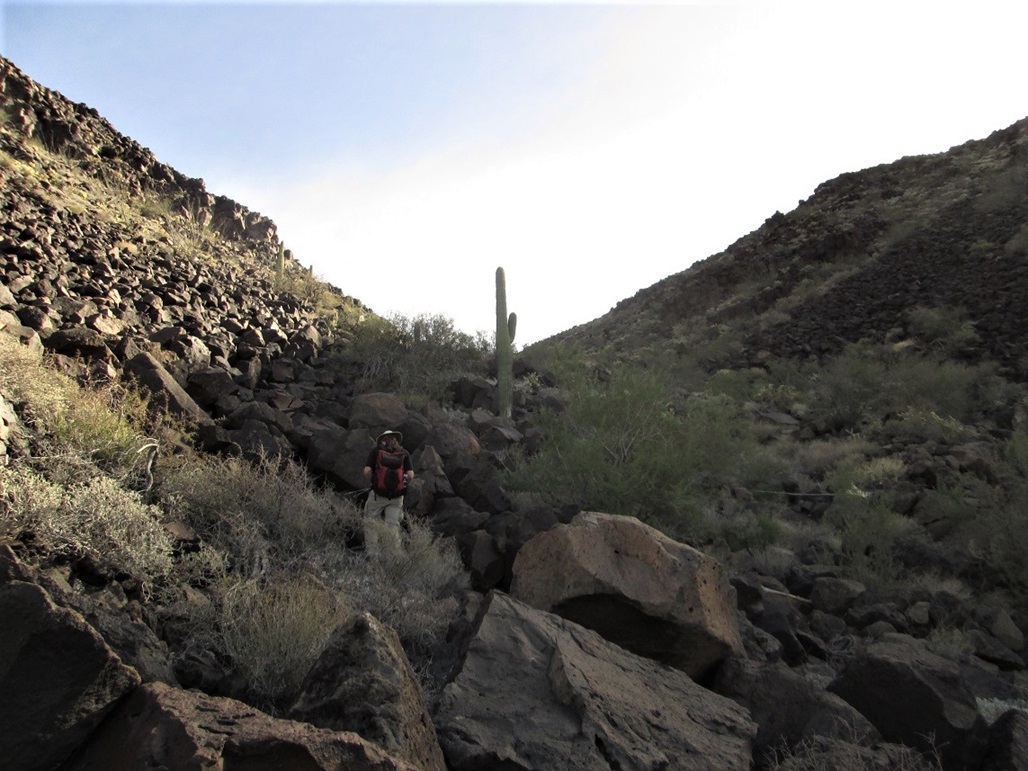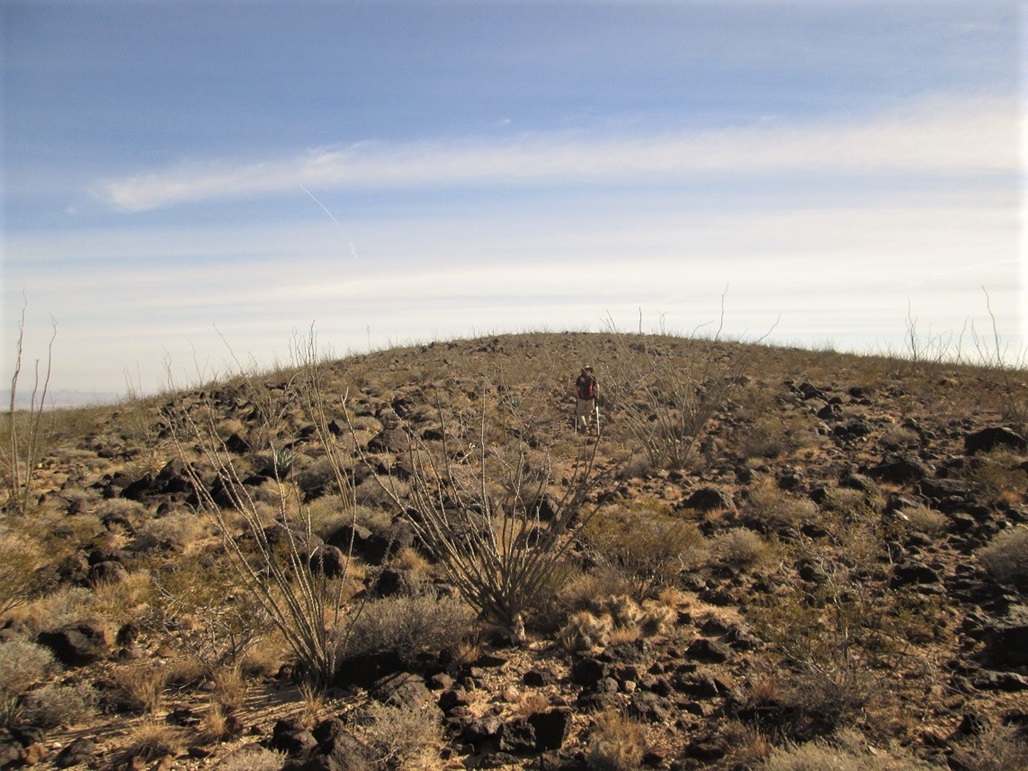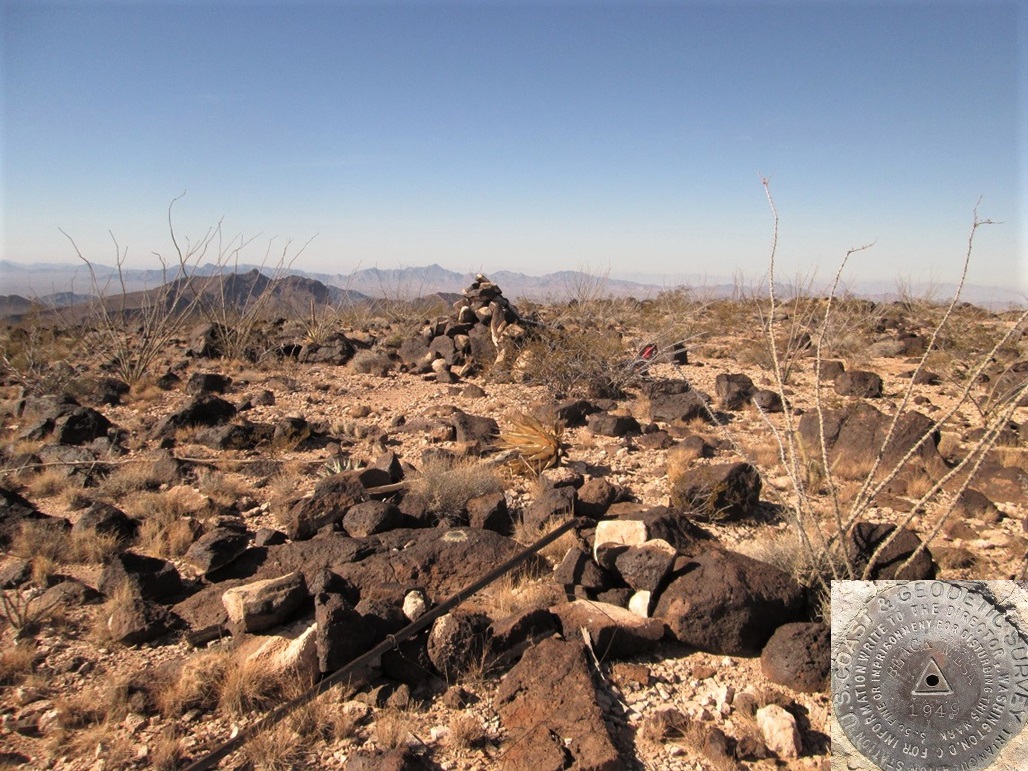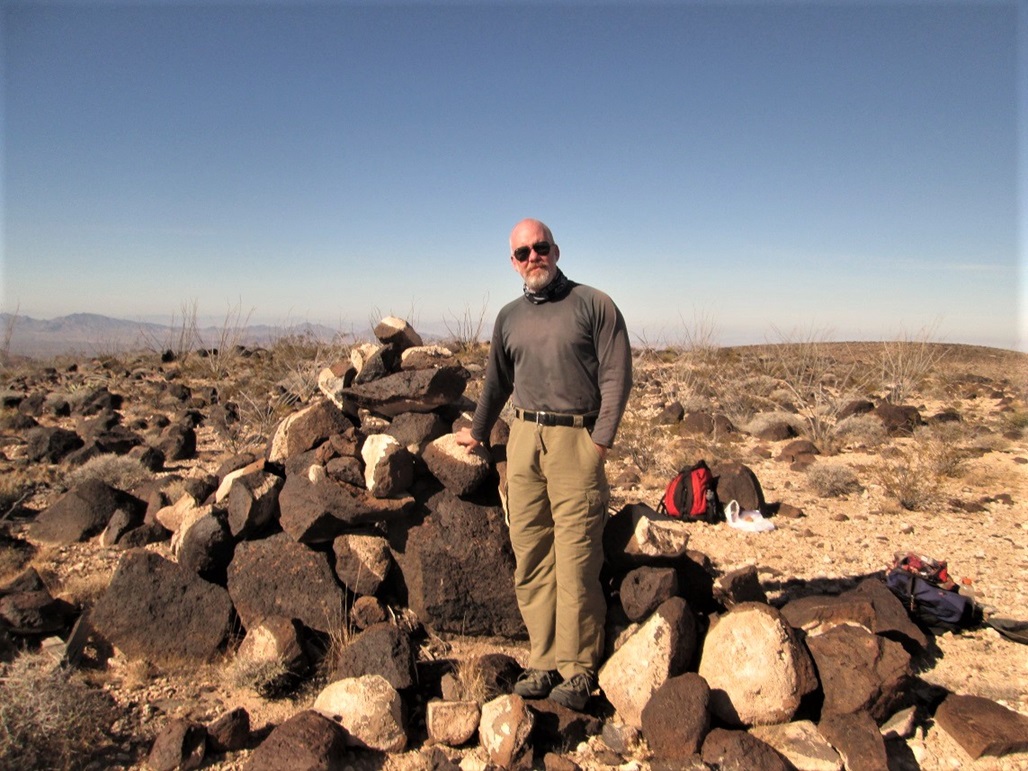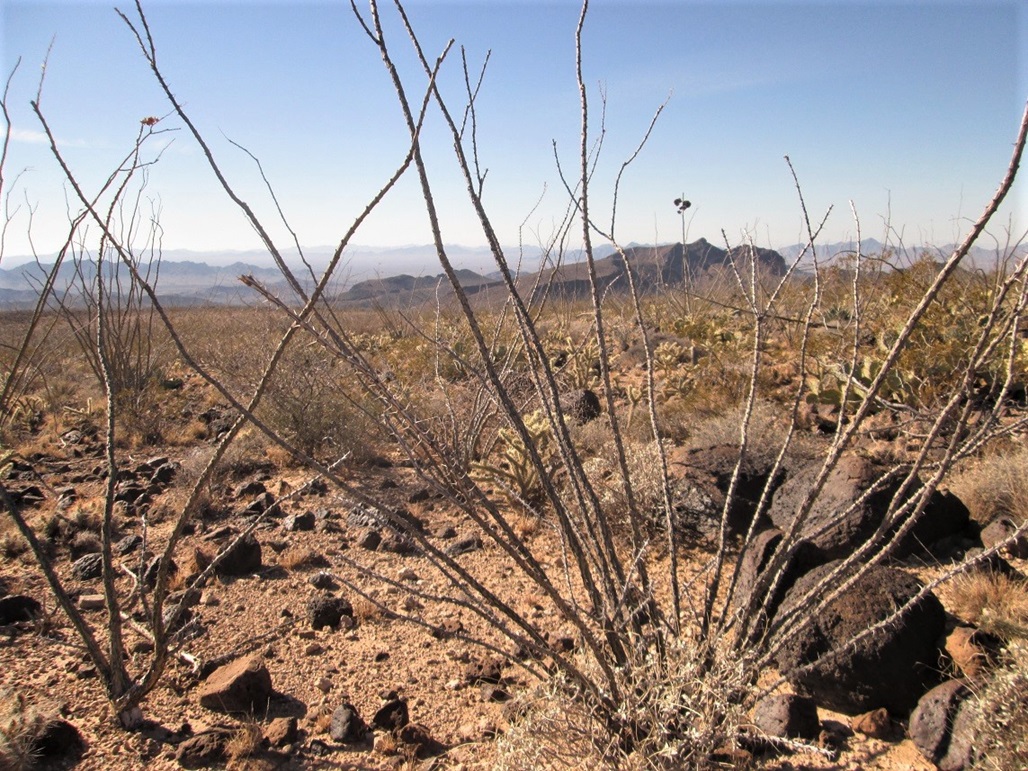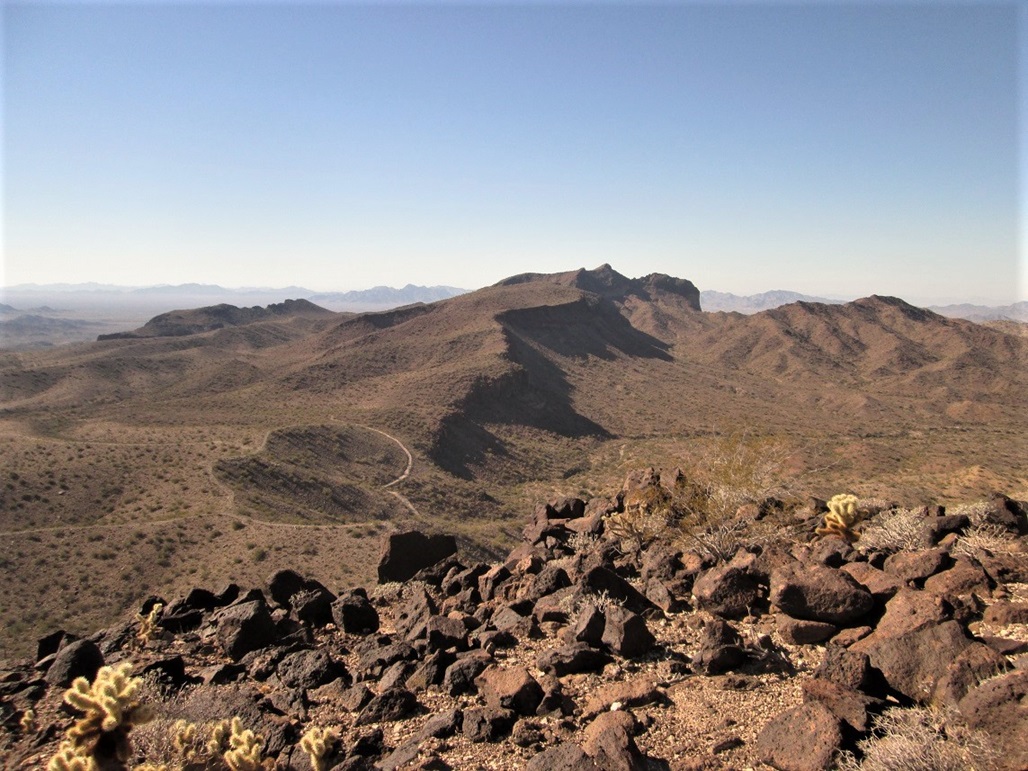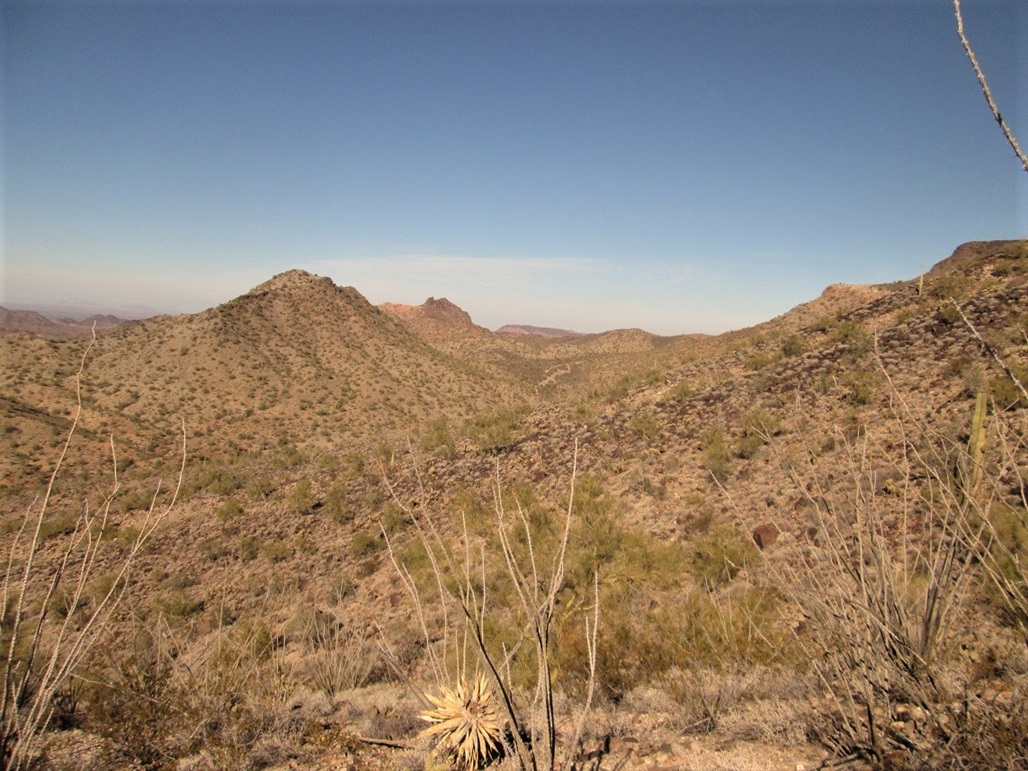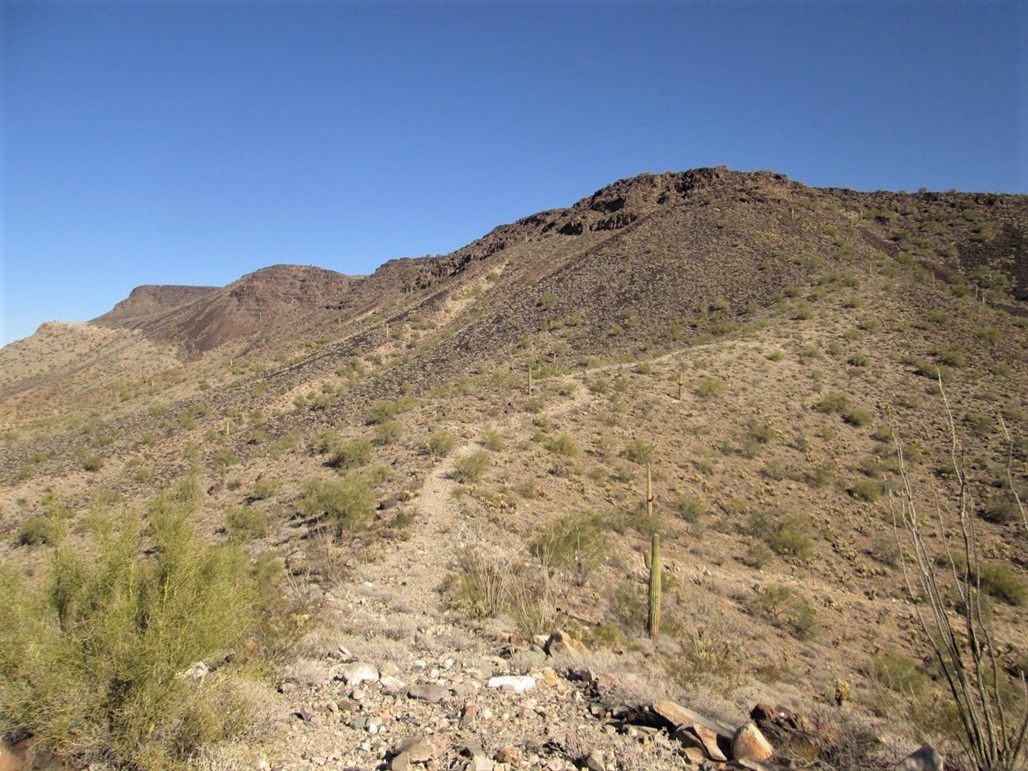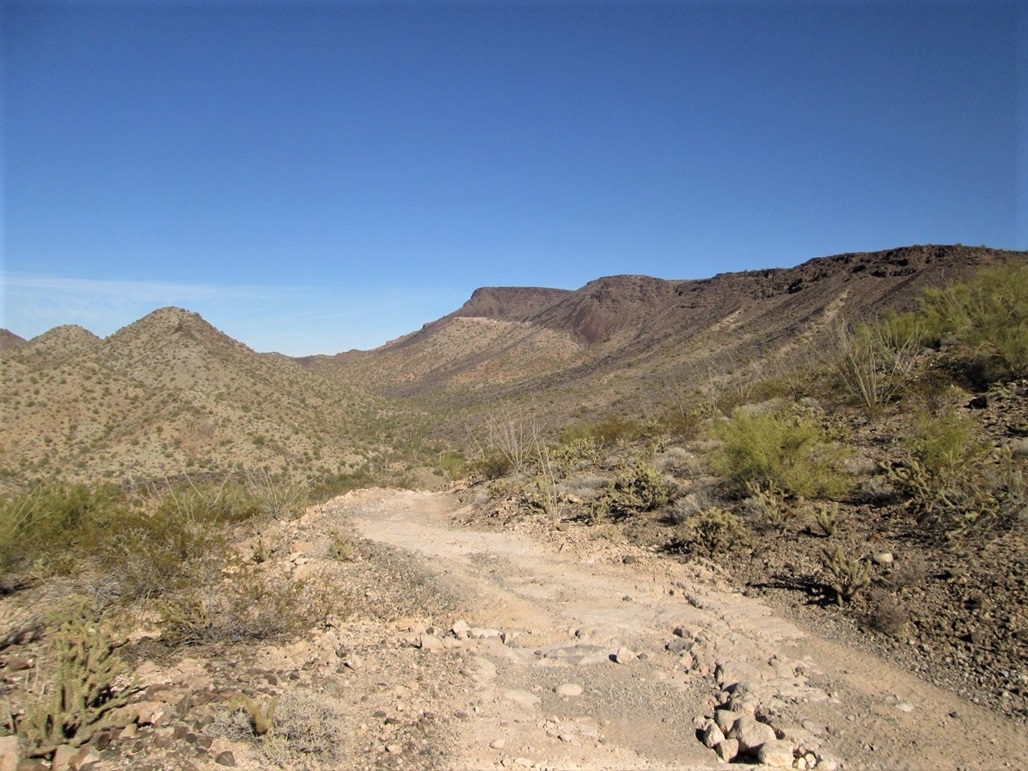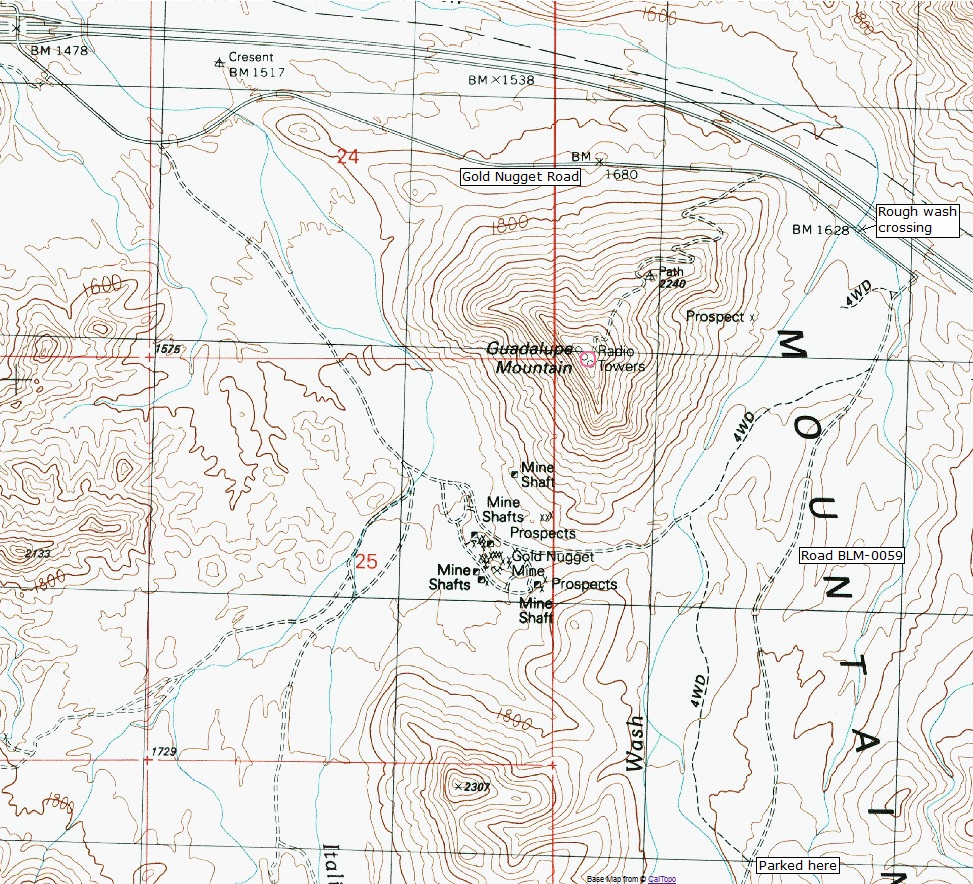
The Mountains of Arizona
• www.surgent.net
|
| Black Mesa • Plomosa Range |
• Range Highpoint: Plomosa Mountains • New Water Mountains Wilderness • La Paz County |
|
Date: December 11, 2016
• Elevation: 3,639 feet
• Prominence: 1,659 feet
• Distance: 13 miles
• Time: 7 hours, 45 minutes
• Gain: 1,840 feet
• Conditions: Clear and warm, a little hazy
• Teammates: Matthias Stender
This Black Mesa is the highest point of the Plomosa Mountains in La Paz County, western Arizona. Interstate-10 cuts through the range at Plomosa Pass, near where US-60 splits off the interstate, about five miles east of Quartzsite. Looking south, Black Mesa is the big mesa that rises high, about five miles distant, with a black color. The name is appropriate, but not terribly original. This would be my third "Black Mesa" that I have ascended within the state.
Black Mesa lies within the New Water Mountains Wilderness, despite the fact it's part of the Plomosa Range, the New Water Mountains being a few miles to the east. Rough BLM roads go south into the hills, one forming the western boundary of the wilderness, which meant it could be driven if so desired.
Matthias and I were mulling over places to go, and he mentioned this peak as a destination, and I was interested. I have pondered it on my various travels along the interstate. We agreed to meet early and try to time our arrival for sun-up. We met at 5 a.m. and got moving, arriving to the Gold Nugget Road exit a little after 7 a.m., the sun still very low but with enough light so that we could see the area. Gold Nugget Road is paved and fronts the interstate on the south side for about two miles. A dirt side road veers off immediately and heads for the Gold Nugget Mine, about two miles to the south. We stayed straight (east), the road now cutting across the north slopes of Guadalupe Mountain, which is the big peak right beside the interstate with all the towers on it.
A few yards past Guadalupe Mountain, we came to the first obstacle: the pavement ends and the road drops into a gravelly wash. The drop is rutted and with big rocks. I got out to guide Matthias through. On the other side, the pavement continued, but not for long. Soon, we were at the junction of BLM Road 0059 (henceforth, "Road 59"). This is the road that goes south into the range.
(The pavement on Gold Nugget Road is old and unkempt, and essentially big chunks of asphalt still clumped together on the ground. Brush and palo verde grow thick on the sides, and any parts that cross arroyos have long since worn away into gravel and sand. That wash crossing mentioned earlier would stop low-clearance passenger vehicles. High clearance with power is a minimum requirement.)
Now on Road 59, we rumbled along slowly, inching up an 80-foot incline in which I had to get out and move aside a lot of bigger rocks and guide Matthias through some rutted parts. It wasn't a bad road, but we didn't want to take chances. Now on top a flat bench, the road improved and we got in another mile to a point where the road dropped into Poormans Wash, the main wash that emanates from the range. This road was in poor shape, probably too much for Matthias' vehicle. So we parked here, elevation 1,840 feet. We had got in about two miles from Gold Nugget Road, leaving about four miles (line of sight) to Black Mesa. We were half-expecting to not get in very far, so we were ready for a long road hike.
We started hiking at 7:55 a.m., the sun still blocked by the hills to the east. The morning was chilly but not uncomfortable. We immediately descended into Poormans Wash, and kept to the road, losing about a hundred feet in two or thee declines. We then came to where the road that goes to Gold Nugget Mine meets this road. This was about a mile from where we parked. Another mile later, we were within the Apache Chief Mine, which is posted, apparently still owned by someone.
Here, we came upon a stone shack in a cleared area abutting some low hills. The actual mine is up there in one of those hills. We were more interested in the shack itself. It was open to the elements, but the interior looked like it had new and recent "things" in it. Perhaps the mine owenr lives here sometimes but doesn't lock up the place when he leaves. Or more likely, the handful of hikers and off-roaders have added trinkets to it over time. It was an odd little place.
The road then curned a little east, and we kept to it, markers along the way re-assuring us we were on Road 59. There were so many side roads, all called 59A or 59B, etc., that I got concerned we had veered off one of these side roads, but we always kept to the obvious main road. In this section, the road followed a long wash (called Apache Wash) and was a coarse gravel, which made walking a little laborious.
In about 90 minutes, we had covered just under four miles (my estimation), arriving at a faint side track that veers east toward a low peak called Peak 2927. This track shows on the map. It gains about 200 feet, cuts south of Peak 2927, drops about 80 feet, then bends north and east again toward old mine shafts. This segment covered about a mile, the mines at about 2,850 feet. We took a break here. I sat near a vertical shaft, the only barrier a single strand of barbed wire.
We were below a gully that cuts into the mesa, north of the summit and south of a slightly-lower lobe of the mesa. This gully looked friendly from below. Otherwise, virtually the whole western rim of the mesa is a series of cliffs.
Past the mines, the road ends and we eased into the gully, and immediately it closed in tightly. There was lots of brush and palo verde. The climbing was easy as there were no cliffs, but the brush slowed us. After a few dozen yards, the constriction opens up a little, and we escaped the gully by climbing up a stone slope. From here to the mesa-top was about 500 vertical feet, the gully leaning back nicely. We hopped from rock to rock, all of it black basalt lava rocks. The rocks were big and solid, but we moved carefully. Brush was heavy, including cholla and staghorn cactus.
After about 45 minutes, we were at the top of the gully, essentially on top the mesa. We angled south and walked up a slope, then aimed for the top. On the mesa top, the land was flat but covered in lava boulders. There was lots of cactus and lots of ocotillo, a virtual forest of ocotillo! Getting to the top was easy, and we arrived here at 11:45, just under four hours, and about 5.5 miles, possible 6, from where we parked.
The day was pleasant and sunny, temperature about 70 degrees, the Polar Vortex obviously having a big effect here in the Southwest. But the still air and the reflective rocks added about 5 degrees to the temperature. If there was a breeze, it felt good. Otherwise, it was kind of warm. We looked around, spying Signal Peak, Cunningham Mountain and Harquahala Mountain, among other peaks. There was enough moisture in the air to create a low haze to mush out long-distance views. Still, the views were nice. We spent about a half hour up here.
The map shows two 3,600-foot contours atop the mesa, the other one north of us. I sighted over to it using a water bottle and it was lower, but probably not by much. I called it about 5 to 10 feet lower. The map marks off in 40-foot contours and given that were we at 3,639 feet, the chances of that lobe being higher is very small. The summit area, where we were, is big and spread out, and we tagged a number of rocks that could be the highest point. A massive stone cairn marks the top, the benchmark a few yards away. We could not find a register.
I was not eager to go back down that gully, and was interested in exploring an alternative way off the mesa, aiming southwest toward a saddle that connects Black Mesa to Dripping Springs Peak. Road 59 comes up and over this saddle and it looked like we could get to the road faster this way, although it would add distance. Matthias was agreeable and we started off that way, dropping about 400 feet in a mile. We kept to the west edge of the rim and when we were above the saddle, we found a weakness in the mesa where there did not appear to be any cliffs. We descended down this bowl, losing about 400 feet and placing us onto another miner's track, which then led out to the main road. This plan worked well.
Now back on Road 59, we started the long walk out to the car. We were over five miles away, so we just started walking, taking breaks every now and then. The lighting was much better for photographs—most of what you see here was taken as we walked out. The hike out took about two hours, and we were back to Matthias' vehicle just before 4 p.m.. I estimate the return hike added about a mile, for a 13-mile round trip hike.
We changed into dry clothes, slowly drove back to Gold Nugget Road, then had a fun time getting back up that washed-out part mentioned earlier. At one point, Matthias was spinning his wheels, so he had to reverse, then gun it forward to get up the rocks. Once on pavement, the drive home took a couple hours. We stopped for snacks at the Vicksburg Exit, then arrived back to the Phoenix area about 7 p.m.
As always, I am grateful the hike went well with no mishaps, no stuck vehicles, no snakebites or bee stings. Thanks to Matthias for driving and once again choosing high-quality prog rock such as King Crimson, early ELP (In honor of Greg Lake, who passed away this past week), and Soft Machine for the drive. Once back in Scottsdale, I treated myself to Hawaiian take-out, then rested and relaxed with my wife and cats.
|
|
